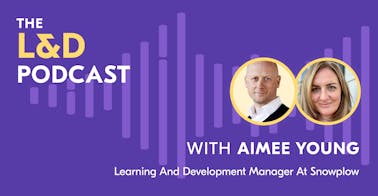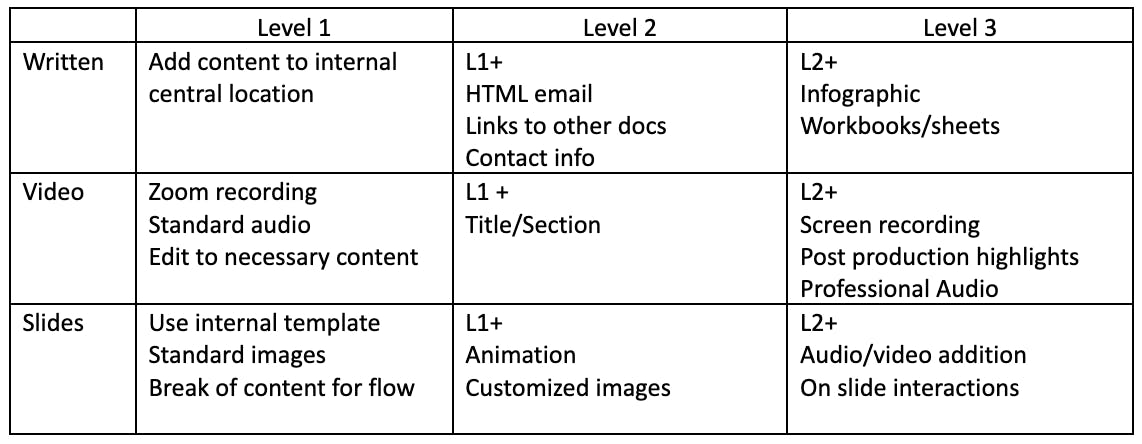
Why organizations may have one person working in L&D
Budget constraints are a common reason organizations have only one person working in L&D. The L&D department may not have a budget for tools or human resources, leaving the lone L&D professional to manage all aspects of learning and development. Additionally, the organization may use role-sharing with another team to fulfill L&D functions. For example, L&D functions may be combined with customer success, support, or even product management.
Another common reason for having only one person in L&D is due to the organization's youth in time and/or experience. If the organization is focused on releasing its first product, all resources are typically directed towards engineering and product management, leaving out learning and development. Similarly, if the organization has released one product in the suite and is now concentrating on creating a companion product to expand the enterprise footprint within existing customers, learning and development may not be prioritized.
Lastly, L&D may be pigeonholed by leaders who have a biased view of L&D. This often happens when leadership lacks understanding of how learning is an underpinning that must grow with the product and organization. For instance, when executives move from large mature companies (think Oracle, Microsoft), they may see L&D as only to support organizations of that size and scale. In addition, leadership may perceive learning and development as equivalent to their experience in schooling and therefore not see the many benefits of it in their growing organization.

Want more subject-matter experts on your team?
By providing your contact info, you agree to receive communications from 360Learning. You can opt-out at any time. For details, refer to our Privacy Policy.
Facing common challenges
Most L&D professionals and especially solo teams face several challenges, including tunnel vision on product and sales. It is true that without the product or sales, the company cannot survive. However, without a paced learning process, the company cannot grow. For example, think of a tower of cards. As more cards are added to the top, the weight increases, and the base must support that weight. However, if the base is not strong enough, the tower will collapse. This analogy can be applied to businesses as well. If an organization focuses too much on growth and profits without investing in a solid foundation of employee training and development, the business may struggle to sustain that growth and could ultimately fail.
L&D is all too often pushed to the wayside until there's a desperate need for its benefits. The problem with waiting so long is lost time. Planning is an essential element of L&D that you just can't skip! Without adequate time, effort, and clear outcomes, learning won't happen with the necessary quality and consistency.
If learning isn't baked right into the organization’s process, then the whole development and distribution process will be thrown off, leaving L&D high and dry without the support it needs to really thrive. To fight this challenge, keep in close contact with your subject matter experts (SME), leadership, and operations teams by attending SCRUM meetings, product release planning, and quarterly sales kickoffs, to name just a few.
All about alignment
To get the most buy-in for L&D, it's important for learning professionals to show their value to the company. They need to bust myths about what L&D does and explain in plain terms how they fit into the organization. It's also key for them to dig into what's happening behind the scenes in L&D, and help internal SMEs by acting as consultants and supporting them with independent content creation.
L&D professionals need to make sure that they're delivering results that align with the company's short-term goals. That means they must set boundaries with leadership and management, so everyone understands the L&D team’s bandwidth and scope. For example, L&D can help managers hold their teams accountable for learning, but they can't be responsible for ensuring that everyone applies what they've learned on the job.
It's also important for L&D professionals to know how to manage requests from different departments and prioritize them based on the company's most urgent goals. That way, they can create content that's most beneficial for the organization. And if something changes, they need to be ready to pivot and adjust their plans.
Bucketing deliverables
Learning professionals often find themselves spending a significant amount of time creating deliverables. Whether it's written content, videos, live presentations, or imagery, the decision on how much time to spend on creating these materials is crucial in managing efficiency. To make the learning process more efficient, L&D professionals can group each type of deliverable into three production level buckets. The production level can be determined based on factors such as the shelf life of the content, the type of learner (internal vs. external), and the urgency of delivery. However, L&D professionals should prioritize function over fancy and know what is expected from each production level bucket.
Figure 1: Sample of production buckets

Once you’ve identified the structure of your buckets , then the bucketing process can begin. Below are a couple examples of how this could look.
Figure 2: Two examples of bucket application

Example 1: A new PTO policy is rolling out to all remote workers 3 months from today.
Example 2: A highly requested feature is in the next update and the product team wants to let all of your users know how and when to use it in the release going out next week.
Set boundaries with leadership and management, so everyone understands the L&D team’s bandwidth and scope.
Solo L&D professionals play a critical role in creating a learning culture that drives business growth and success, and by taking the key actions outlined above, they can overcome common challenges and demonstrate the value of learning and development to the organization.
To recap, these are the recommended steps to build effective and adaptable learning initiatives:
- Align L&D strategy with the organization's goals
- Support subject matter experts to ensure accurate and relevant content
- “Bake” in L&D to existing knowledge sharing opportunities
- Deliver results to leadership that align with urgent quarterly outcomes
- Draw boundaries on influence and understand the limits of L&D's role
- Bucket deliverables based on speed, quality, and accuracy
- Be prepared to pivot when necessary while keeping existing content
- Create a way for anyone in the organization to request and create content
- Focus on function over fancy in terms of production value
By taking these actions, solo L&D experts can overcome common challenges such as limited resources, tunnel vision on product and sales, and lack of support for their work. They can demonstrate the value of learning and development to the organization and create a learning culture that drives business growth and success.




